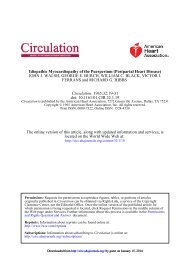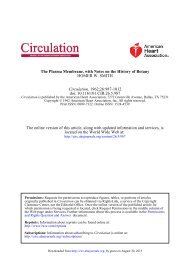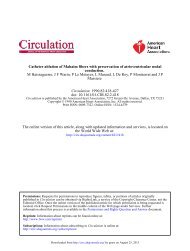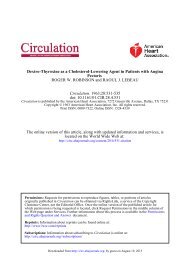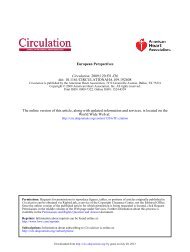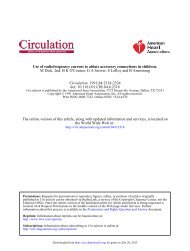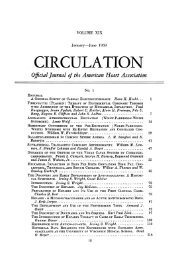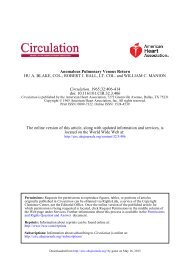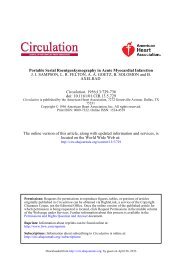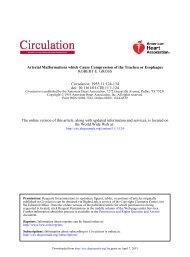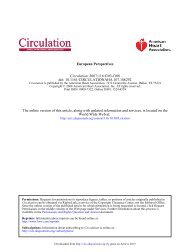Hemostatic Effects of Tranexamic Acid and Desmopressin During ...
Hemostatic Effects of Tranexamic Acid and Desmopressin During ...
Hemostatic Effects of Tranexamic Acid and Desmopressin During ...
Create successful ePaper yourself
Turn your PDF publications into a flip-book with our unique Google optimized e-Paper software.
<strong>Hemostatic</strong> effects <strong>of</strong> tranexamic acid <strong>and</strong> desmopressin during cardiac surgery.<br />
J C Horrow, D F Van Riper, M D Strong, I Brodsky <strong>and</strong> J L Parmet<br />
Circulation. 1991;84:2063-2070<br />
doi: 10.1161/01.CIR.84.5.2063<br />
Circulation is published by the American Heart Association, 7272 Greenville Avenue, Dallas, TX 75231<br />
Copyright © 1991 American Heart Association, Inc. All rights reserved.<br />
Print ISSN: 0009-7322. Online ISSN: 1524-4539<br />
The online version <strong>of</strong> this article, along with updated information <strong>and</strong> services, is located on<br />
the World Wide Web at:<br />
http://circ.ahajournals.org/content/84/5/2063<br />
Requests for permissions to reproduce figures, tables, or portions <strong>of</strong> articles originally<br />
published in Circulation can be obtained via RightsLink, a service <strong>of</strong> the Copyright Clearance Center, not the<br />
Editorial Office. Once the online version <strong>of</strong> the published article for which permission is being requested is<br />
located, click Request Permissions in the middle column <strong>of</strong> the Web page under Services. Further<br />
information about this process is available in the Permissions <strong>and</strong> Rights Question <strong>and</strong> Answer document.<br />
Permissions:<br />
Reprints: Information about reprints can be found online at:<br />
http://www.lww.com/reprints<br />
Subscriptions: Information about subscribing to Circulation is online at:<br />
http://circ.ahajournals.org//subscriptions/<br />
Downloaded from<br />
http://circ.ahajournals.org/ by guest on April 20, 2013
<strong>Hemostatic</strong> <strong>Effects</strong> <strong>of</strong> <strong>Tranexamic</strong> <strong>Acid</strong> <strong>and</strong><br />
<strong>Desmopressin</strong> <strong>During</strong> Cardiac Surgery<br />
Jan C. Horrow, MD; Daniel F. Van Riper, MD; Michael D. Strong, MD;<br />
Isadore Brodsky, MD; <strong>and</strong> Jonathan L. Parmet, MD<br />
Background. <strong>Desmopressin</strong>-induced release <strong>of</strong> tissue plasminogen activator from endothelial<br />
cells may explain the absence <strong>of</strong> its hemostatic effect in patients undergoing cardiac surgery.<br />
Prior administration <strong>of</strong> the antifibrinolytic drug tranexamic acid might unmask such an effect,<br />
<strong>and</strong> combination therapy might thereby improve postoperative hemostasis.<br />
Methods <strong>and</strong> Results. A double-blinded design r<strong>and</strong>omly allocated 163 adult patients<br />
undergoing coronary revascularization, valve replacement, both procedures, or repair <strong>of</strong> atrial<br />
septal defect to four treatment groups: placebo, tranexamic acid given as 10 mg/kg over 30<br />
minutes followed by 1 mg * kg`. hr-' for 12 hours initiated before skin incision, desmopressin<br />
given as 0.3 jig/kg over 20 minutes after protamine infusion, <strong>and</strong> both drugs. One surgeon<br />
performed all operations. Blood loss consisted <strong>of</strong> mediastinal tube drainage over 12 hours.<br />
Follow-up visits sought evidence <strong>of</strong> myocardial infarction <strong>and</strong> stroke. <strong>Desmopressin</strong> decreased<br />
neither the 12-hour blood loss nor the amount <strong>of</strong> homologous red cells transfused. <strong>Tranexamic</strong><br />
acid alone significantly reduced 12-hour blood loss, by 30%1 (mean, 318 versus 453 ml;<br />
p
2064 Circulation Vol 84, No 5 November 1991<br />
more, or a personal or family history <strong>of</strong> abnormal<br />
bleeding; or underwent intra-aortic balloon counterpulsation.<br />
Patients receiving aspirin within 7 days <strong>of</strong><br />
operation, heparin infusion within 8 hours, or nonsteroidal<br />
anti-inflammatory medication within 3 days<br />
could participate but were r<strong>and</strong>omized separately to<br />
permit even distribution among groups. Participation<br />
<strong>of</strong> these patients permits application <strong>of</strong> the study<br />
results to a representative population <strong>of</strong> elective<br />
surgical patients. The large number <strong>of</strong> patients enrolled<br />
in the study <strong>and</strong> separate r<strong>and</strong>omization<br />
schedule limit any confounding effect <strong>of</strong> their inclusion<br />
on outcome variables. Enrolled patients underwent<br />
coronary revascularization, valve replacement,<br />
both procedures, or atrial septal defect repair.<br />
Group Assignments<br />
A table <strong>of</strong> r<strong>and</strong>om numbers determined patient<br />
allocation to one <strong>of</strong> four groups. The placebo group<br />
(group P) received saline infusions. A second group<br />
(group T) received tranexamic acid beginning after<br />
induction <strong>of</strong> anesthesia but before skin incision<br />
(loading dose, 10 mg * kg` over 30 minutes) followed<br />
by a 12-hour infusion <strong>of</strong> 1 mg . kg-1' hr-1. A third<br />
group (group D) received desmopressin acetate (0.3<br />
gg kg`1 i.v. over 20 minutes) beginning after ECC<br />
following completion <strong>of</strong> protamine infusion. Patients<br />
in the fourth group (group B) received both tranexamic<br />
acid <strong>and</strong> desmopressin in identical fashion to<br />
groups T <strong>and</strong> D. Coded infusion bags <strong>and</strong> sealed<br />
envelopes prepared by a pharmacist not involved in<br />
the study provided double-blinded conditions. Actual<br />
group assignments became known months after patient<br />
participation ended.<br />
Anticoagulation<br />
Beef lung heparin (Organon, West Orange, N.J.)<br />
- (400 units kg-') provided anticoagulation for ECC.<br />
Automated activated coagulation time (Hemochron,<br />
International Technidyne Corp., Edison, N.J.) greater<br />
than 480 seconds, determined in duplicate every 30<br />
minutes, ensured continued anticoagulation. For ECC,<br />
nonocclusive roller pumps, membrane oxygenators,<br />
cold sanguinous cardioplegic arrest, <strong>and</strong> systemic hypothermia<br />
to 25°C were used. The ECC circuit initially<br />
contained 5,000 units <strong>of</strong> beef lung heparin in 21 <strong>of</strong> clear<br />
fluid prime (Plasmalyte A solution, Baxter Healthcare<br />
Corp., Deerfield, I1l.). Termination <strong>of</strong> ECC required a<br />
distal esophageal temperature <strong>of</strong> 37°C or greater <strong>and</strong><br />
urinary catheter temperature <strong>of</strong> 34°C or greater. After<br />
ECC, protamine (4 mg* kg-') neutralized heparin to<br />
obtain an activated coagulation time within 15 seconds<br />
<strong>of</strong> baseline.13 Infusion <strong>of</strong> residual blood from the extracorporeal<br />
circuit followed approximation <strong>of</strong> the sternal<br />
wound edges. A subsequent additional protamine infusion<br />
(30% <strong>of</strong> the initial dose) neutralized heparin in the<br />
pump blood <strong>and</strong> protected against heparin rebound,'4<br />
as confirmed by repeat activated coagulation time.<br />
Blood Loss<br />
The mass <strong>of</strong> blood collected via mediastinal drains<br />
over 12 hours constituted blood loss. No attempt was<br />
made to estimate blood loss before or during ECC, or<br />
before insertion <strong>of</strong> mediastinal drainage tubes. The<br />
study ignored estimates <strong>of</strong> irrigation fluid, sponge<br />
<strong>and</strong> suction container losses, <strong>and</strong> soaking <strong>of</strong> linens;<br />
all <strong>of</strong> these minor components <strong>of</strong> operative blood loss<br />
are notoriously inaccurate. Blood loss occurring between<br />
protamine infusion <strong>and</strong> mediastinal tube<br />
placement contributes trivially to overall blood loss<br />
(unpublished data, G. Gravlee). All mediastinal<br />
blood lost after initial heparin administration until<br />
termination <strong>of</strong> ECC was eventually returned to the<br />
patient via the ECC circuit. After ECC, a citrated<br />
autotransfusion drainage system (Pleur-evac, Deknatel,<br />
Queens Village, N.Y.) permitted return <strong>of</strong> shed<br />
blood to those patients experiencing initial rapid<br />
blood accumulation via mediastinal tubes.<br />
Transfusion<br />
Transfusion <strong>of</strong> packed red blood cells in the first<br />
12 hours after surgery required one or more <strong>of</strong> the<br />
following: hematocrit less than 21% measured at<br />
least 1 hour after surgery, chest tube drainage <strong>of</strong><br />
250 ml . hr-1 or more, or hematocrit less than 24%<br />
associated with hemodynamic signs <strong>of</strong> hypovolemia,<br />
defined as heart rate greater than 110 beats per<br />
minute <strong>and</strong> pulmonary arterial diastolic pressure<br />
less than 10 mm Hg. Transfusion <strong>of</strong> fresh frozen<br />
plasma or platelets required brisk (250 ml . hr-' or<br />
more) bleeding <strong>and</strong> a strong suspicion or laboratory<br />
confirmation <strong>of</strong> deficiency in coagulation factors or<br />
decrease in platelet count, respectively. All red cell<br />
transfusions in the first 12 hours were weighed<br />
before administration. The weight <strong>of</strong> the filled<br />
container minus that <strong>of</strong> an empty bag (34 g) constituted<br />
the mass administered. After 12 hours, strict<br />
transfusion criteria no longer applied; clinician<br />
preference supervened. Each subsequent unit <strong>of</strong><br />
packed red blood cells given to the patient contributed<br />
300 g toward total transfusion mass.<br />
Coagulation Tests<br />
Before induction <strong>of</strong> anesthesia <strong>and</strong> again 2 hours<br />
after completion <strong>of</strong> initial protamine infusion, assessment<br />
<strong>of</strong> coagulation proceeded with measurement <strong>of</strong><br />
activated partial thromboplastin time, manual platelet<br />
count, plasma fibrinogen,15 factor VIII coagulant<br />
activity, serum fibrin-fibrinogen-related antigen (latex<br />
agglutination, Thrombo-Wellco Test, Burroughs<br />
Wellcome, Research Triangle Park, N.C.), <strong>and</strong> latex<br />
agglutination D-dimer (D-di, American Bioproducts,<br />
Parsippany, N.J.). D-dimer is a specific breakdown<br />
product <strong>of</strong> factor XIIIa-stabilized, cross-linked fibrin.<br />
Template bleeding times were omitted because<br />
<strong>of</strong> difficulty with patient access.<br />
Downloaded from<br />
http://circ.ahajournals.org/ by guest on April 20, 2013
Horrow et al <strong>Hemostatic</strong> Drugs <strong>and</strong> Cardiac Surgery 2065<br />
TABLE 1. Demographic <strong>and</strong> Other Descriptors <strong>of</strong> Patient Groups<br />
Placebo <strong>Desmopressin</strong> <strong>Tranexamic</strong> acid Both<br />
n 44 38 37 40<br />
Age (yr) 64± 10 63±11 65±11 63±9<br />
Weight (kg) 77± 15 74± 15 80±23 82± 16<br />
Height (in.) 67±4 66±3 67±3 68±4<br />
BSA (m2) 1.9±0.24 1.8±0.22 1.8±0.19 1.9±0.23<br />
ACB 36 (82%) 32 (84%) 26* (70%) 34 (85%)<br />
Valve 6 3 6t 6<br />
Combined 2 2 2 0<br />
ASD 0 1 3 0<br />
Repeat operation 5 3 1 5<br />
ECC (min) 98±33 92±34 87±40 92+31<br />
Pump blood (g) 660±137 697±173 689±171 649±+110<br />
Shed blood given 17 10 7 5<br />
Shed blood (g)t 386 (149-860) 418 (200-650) 343 (156-505) 185 (164-385)<br />
Initial Hct (%) 37±5 37±5 36±5 36±4<br />
Hct after ECC (%) 25±5 24±4 25±4 26±4<br />
Hctin ICU (%) 26±5 25±5 27±4 27±4<br />
Entries are number <strong>of</strong> patients (percent), mean±SD, or median (range).<br />
BSA, body surface area; ACB, aortocoronary bypass grafting; Valve, valve replacement; Combined, simultaneous<br />
valve replacement <strong>and</strong> ACB; ASD, repair <strong>of</strong> atrial septal defect; ECC, duration <strong>of</strong> extracorporeal circulation; Pump<br />
blood, mass <strong>of</strong> pump fluid infused after sternal approximation; Shed blood, mass <strong>of</strong> mediastinal shed blood infused<br />
after surgery; Hct, packed red cell volume before incision (initial), after protamine administration (after ECC), <strong>and</strong> 2<br />
hours after protamine administration (in ICU).<br />
*Includes one combined coronary revascularization with carotid endarterectomy.<br />
tlncludes one open mitral commissurotomy.<br />
tMedian <strong>and</strong> range <strong>of</strong> shed blood mass are only for those patients who received shed blood, the number <strong>of</strong> whom<br />
is indicated in the row immediately above.<br />
Follow-up<br />
Daily visits to each patient sought evidence <strong>of</strong><br />
myocardial infarction <strong>and</strong> stroke. Myocardial infarction<br />
required new Q waves on the electrocardiogram<br />
or creatine kinase-MB more than 19 units 1-1.16<br />
Stroke diagnosis required a new focal deficit confirmed<br />
by computed tomography.<br />
Data Analysis<br />
For normally distributed data, two-way analysis <strong>of</strong><br />
variance interpreted the data, using as factors 1)<br />
administration <strong>of</strong> tranexamic acid, 2) administration<br />
<strong>of</strong> desmopressin, <strong>and</strong> 3) interaction term. This analysis<br />
automatically separates out the independent<br />
contribution <strong>of</strong> each single drug <strong>and</strong> its contribution<br />
to group B data, expressing any remaining effect as<br />
an interaction term. This interaction term thus denotes<br />
synergism or antagonism <strong>of</strong> the two drugs on<br />
the measured parameter. Except in cases where an<br />
interaction is known to be absent, interaction terms<br />
are included in a two-way analysis <strong>of</strong> variance model,<br />
with any remaining effect attributed to error. Where<br />
appropriate, significant effects among the four<br />
groups were explored further with the Newman-<br />
Keuls multiple range test. Parametric data are reported<br />
as mean±SD.<br />
Blood loss data did not conform to the normal<br />
distribution. However, logarithmic transformation<br />
yielded normally distributed values, permitting twoway<br />
analysis <strong>of</strong> variance on these transformed data,<br />
which are reported as mean <strong>and</strong> 95% confidence<br />
intervals <strong>of</strong> the back-transformed values.<br />
Paired Student's t test compared postoperative<br />
versus preoperative coagulation data. Comparisons<br />
among the four groups <strong>of</strong> nonparametric data were<br />
done by Kruskal-Wallis analysis. Median <strong>and</strong> range<br />
statistics report nonparametric data.<br />
Frequency data underwent contingency table analysis<br />
using likelihood ratio x2 statistics. Compressed 2x2<br />
frequency tables, which tested the separate effects <strong>of</strong><br />
each drug, used Fisher's exact test. In a compressed<br />
table, the entries for groups B <strong>and</strong> T, for example,<br />
would be added columnwise, as are those for groups D<br />
<strong>and</strong> P, to test for an effect <strong>of</strong> tranexamic acid. Since<br />
compressed table analysis might produce spurious results<br />
by failing to separate individual drug effects in<br />
group B, multinomial logistic regression verified the<br />
results from analysis <strong>of</strong> compressed tabular data. This<br />
technique uses Wald statistics <strong>and</strong> the log-likelihood<br />
ratio test17 to determine whether tranexamic acid administration<br />
alone, desmopressin administration alone,<br />
<strong>and</strong> simultaneous administration <strong>of</strong> both agents affect<br />
the outcome frequency variable. All tests are twotailed,<br />
withp
2066 Circulation Vol 84, No 5 November 1991<br />
TABLE 2. Coagulation Tests Before Skin Incision <strong>and</strong> 2 Hours After Protamine<br />
Placebo <strong>Desmopressin</strong> <strong>Tranexamic</strong> acid Both<br />
aPTT (seconds above control)<br />
Baseline 3+8 6+12 3±7 6±18<br />
After surgery 6+13 7+11 7+11 5+8<br />
Platelet count (109 - 1)<br />
Baseline 360+248 354+166 336+97 316± 105*<br />
After surgery 232+105 249±178 231+84 204±68*<br />
Fibrinogen (mg. dl-l)<br />
Baseline 253+83 253±84 244±74 245±94*<br />
After surgery 193±61 185±58 195±57 180±54*<br />
Factor VIII (% activity)<br />
Baseline 117±81 111±49 105±36 121±55<br />
After surgery 105±47 108±52 100±41 115±47<br />
D-dimer (FEU)<br />
Baseline 0.89±1.8 1.3±2.0 1.5±1.9 0.81±0.73t<br />
After surgery 1.6+1.0 2.1±2.0 1.0±0.63 0.81±0.70tt<br />
FSP.10/Lg ml-l<br />
Baseline 1/44 2/37§ 1/37 0/40<br />
After surgery 15/44 (34%) 13/38 (34%) 7/36§ (19%) 3/40 (8%)11<br />
Entries are mean±SD.<br />
aPTT, activated partial thromboplastin time; FEU, fibrinogen equivalent units (normal
TABLE 3. Mass <strong>of</strong> Blood (g) Drained Via Mediastinal Tubes Over<br />
12 Hours<br />
95% Confidence<br />
Group n Mean* interval<br />
Placebo 44 462 404-529<br />
<strong>Desmopressin</strong> 38 443 392-500<br />
<strong>Tranexamic</strong> acid 37 328 275-392<br />
Both 40 310 271-355<br />
Entries are grams <strong>of</strong> blood drained via mediastinal tubes over 12<br />
hours. Values for the mean <strong>and</strong> 95% confidence interval <strong>of</strong> the<br />
log-normal distribution are back-calculated from the logarithmically<br />
transformed data.<br />
*Two-way analysis <strong>of</strong> variance shows an effect <strong>of</strong> tranexamic<br />
acid (p
2068 Circulation Vol 84, No 5 November 1991<br />
Rn OVu<br />
60 -<br />
% 40-<br />
20-<br />
1<br />
TA+ TA- Desmo+ Desmo-<br />
GROUP<br />
FIGURE 2. The percentage <strong>of</strong>patients receiving homologous<br />
red cell transfusion within 12 hours (stippled columns) <strong>and</strong><br />
within 5 days (open columns) <strong>of</strong> cardiac surgery. *p=0.024;<br />
**p=O.Ol1.<br />
developed left hemiplegia 10 hours later. Table 6<br />
summarizes these complication data.<br />
Discussion<br />
Ongoing thrombin activity19-21 <strong>and</strong> low-grade fibrinolysis12'22'23<br />
accompany ECC. Early trials seeking<br />
hemostatic effects <strong>of</strong> antifibrinolytic medications after<br />
cardiac surgery lacked blinded or r<strong>and</strong>omized<br />
designs.24-27 Although more recent studies have used<br />
currently acceptable experimental methods, these<br />
have all investigated the hemostatic effect <strong>of</strong> EACA<br />
given after ECC, with mixed results.5,28,29 The current<br />
study design featured prophylactic administration <strong>of</strong><br />
an antifibrinolytic drug, tranexamic acid, anticipating<br />
that the etiology <strong>of</strong> a hemostatic diathesis may arise<br />
early during surgery. <strong>Tranexamic</strong> acid is approximately<br />
10-fold more potent than EACA.<br />
Recent attention has focused on desmopressin, an<br />
analogue <strong>of</strong> arginine vasopressin (antidiuretic hormone)<br />
that releases multimers <strong>of</strong> von Willebr<strong>and</strong><br />
factor from endothelial cells. <strong>Desmopressin</strong> exerts a<br />
positive hemostatic effect in patients with hemophilia,30<br />
von Willebr<strong>and</strong> disease,29 <strong>and</strong> uremia.31 Initial<br />
reports showed a salutary effect on bleeding in<br />
patients undergoing more complicated cardiac surgery-valvular<br />
replacement or repeat sternotomy<br />
procedures4-or as a replacement for transfusion<br />
therapy in patients who bleed excessively after surgery.7<br />
However, Rocha et a18 could not demonstrate<br />
a saving in either bleeding or blood administered in<br />
100 adults undergoing valve replacement or repair <strong>of</strong><br />
atrial septal defect. Seear et al10 demonstrated no<br />
benefit <strong>of</strong> desmopressin in 60 children undergoing a<br />
variety <strong>of</strong> cardiac operations. Hackmann et a19 confirmed<br />
no advantage <strong>of</strong> desmopressin as a hemostatic<br />
TABLE 5. Incidence <strong>of</strong> Complications After Surgery<br />
Group n Stroke Cardiovascular<br />
Myocardial<br />
infarction<br />
Placebo 44 0 0 0<br />
<strong>Desmopressin</strong> 38 3 0 0<br />
<strong>Tranexamic</strong> acid 37 1 2 0<br />
Both drugs 40 1 1 0<br />
n, number <strong>of</strong> patients in each group.<br />
Entries are number <strong>of</strong> patients.<br />
pharmaceutical for elective cardiac operations in 150<br />
adults.<br />
In agreement with most studies,8-10,32 the current<br />
investigation demonstrated no effect <strong>of</strong> desmopressin<br />
on mediastinal drainage after surgery. The outcome<br />
data do demonstrate a salutary hemostatic effect <strong>of</strong><br />
antifibrinolytic drug, also in agreement with recent<br />
investigations.56 The current study further demonstrates,<br />
in two ways, the absence <strong>of</strong> potentiation <strong>of</strong><br />
fibrinolysis after cardiac surgery by desmopressin.<br />
First, desmopressin did not affect the presence <strong>of</strong><br />
fibrinogen-fibrin degradation products or D-dimer<br />
concentration. Second, establishment <strong>of</strong> ongoing antifibrinolytic<br />
therapy did not uncover a hemostatic<br />
effect <strong>of</strong> desmopressin over <strong>and</strong> above that provided<br />
by the antifibrinolytic agent alone, as documented by<br />
no synergism with tranexamic acid on 12-hour measured<br />
blood loss <strong>and</strong> on the proportion <strong>of</strong> patients<br />
who received homologous blood within 12 hours <strong>and</strong><br />
within 5 days <strong>of</strong> operation. Near attainment <strong>of</strong> statistical<br />
significance in the 5-day comparison<br />
(p=0.053) suggests that a true effect might be uncovered<br />
with enrollment <strong>of</strong> additional patients. However,<br />
logistic regression analysis supports no effect <strong>of</strong><br />
the combination <strong>of</strong> drugs. Furthermore, because<br />
antifibrinolytic inhibition <strong>of</strong> the transient desmopressin-induced<br />
release <strong>of</strong> tissue plasminogen activator<br />
affected neither 12-hour blood loss nor 12-hour<br />
transfusion requirement, it is reasonable not to challenge<br />
the absence <strong>of</strong> an effect on 5-day transfusion<br />
requirement. Thus, we conclude that administration<br />
<strong>of</strong> both drugs imparts no additional hemostatic effect.<br />
To ensure that inclusion <strong>of</strong> patients taking aspirin did<br />
not influence these results, data were reanalyzed by a<br />
three-way analysis <strong>of</strong> variance with the additional<br />
factor <strong>of</strong> recent aspirin ingestion as defined in<br />
"Methods." Aspirin did not affect blood loss in the<br />
study patients.<br />
This study measured blood loss by mass instead <strong>of</strong><br />
by volume, thus affording two advantages. First,<br />
closed-system mass quantitation provides higher precision<br />
(1 part in 1,000) compared with closed-system<br />
volumetric measure (1 part in 10). Second, the mass<br />
<strong>of</strong> blood with a higher hematocrit will be greater than<br />
the mass <strong>of</strong> the same volume <strong>of</strong> more dilute blood<br />
<strong>and</strong> thus will better represent the greater loss <strong>of</strong> red<br />
cell volume. Since blood density varies between 1.03<br />
<strong>and</strong> 1.04 g. ml-l (hematocrits <strong>of</strong> 20% <strong>and</strong> 30%,<br />
respectively),33 this difference introduces less than<br />
1% error should mass measurements be interpreted<br />
as volume.<br />
By what mechanism might tranexamic acid provide<br />
decreased postoperative bleeding? Unlike other surgical<br />
procedures, in which patients exhibit decreased<br />
fibrinolysis after operation,34 ECC induces a mild<br />
fibrinolytic state, which lasts several hours after operation.1,12<br />
Failure <strong>of</strong> full anticoagulating doses <strong>of</strong><br />
heparin to limit thrombin activity during ECC, as<br />
evidenced by ongoing formation <strong>of</strong> fibrinopeptide-<br />
A,19-21 may incite this fibrinolytic activity. The anticoagulation<br />
margin <strong>of</strong> safety in this study (activated<br />
Downloaded from<br />
http://circ.ahajournals.org/ by guest on April 20, 2013
coagulation time more than 480 seconds instead <strong>of</strong><br />
more than 400 seconds) ensured no coagulation<br />
activity in addition to that already documented.19<br />
These patients exhibited no evidence <strong>of</strong> hypercoagulability<br />
despite inhibition <strong>of</strong> fibrinolytic activity during<br />
<strong>and</strong> after ECC.<br />
Both fibrinolysis <strong>and</strong> partial platelet activation during<br />
ECC with subsequent platelet dysfunction may alter<br />
hemostasis after ECC.l,12 Since plasmin induces platelet<br />
activation, a potential role for lysine-analogue antifibrinolytic<br />
medications is to block plasmin receptors on<br />
platelets, inhibiting local fibrinolysis-induced partial<br />
platelet activation.35 Administration <strong>of</strong> tranexamic acid<br />
before ECC is associated with preserved platelet ADP<br />
<strong>and</strong> decreased bleeding after ECC.36 Aprotinin, a serine<br />
protease inhibitor with antifibrinolytic properties,<br />
preserves platelet glycoprotein receptors <strong>and</strong> platelet<br />
function after ECC.37 Whether antifibrinolytics exert<br />
hemostatic effects by platelet preservation, by inhibition<br />
<strong>of</strong> fibrinolysis, or by both mechanisms remains<br />
unknown.<br />
Is tranexamic acid safe in patients with coronary<br />
artery occlusive disease? Theoretical considerations<br />
suggest that tranexamic acid may be associated with<br />
thrombosis <strong>and</strong> subsequent stroke, myocardial infarction,<br />
or deep vein thrombosis. Case reports <strong>of</strong><br />
renal cortical necrosis from EACA dampened initial<br />
enthusiasm <strong>of</strong> antifibrinolytic therapy.3839 However,<br />
prospective studiesS56,27,28,40,4l failed to confirm a<br />
thrombotic hazard from routine antifibrinolytic administration.<br />
In the current investigation, ethical<br />
considerations prevented subjecting patients to the<br />
additional risks <strong>of</strong> repeat cardiac catheterization to<br />
document graft patency after surgery. Theoretically,<br />
thrombotic complications <strong>of</strong> tranexamic acid should<br />
not occur during cardiac surgery; full systemic anticoagulation<br />
with heparin should protect these patients<br />
from a presumed thrombotic tendency <strong>of</strong> tranexamic<br />
acid.42 Normal coagulation does not return<br />
until approximately 12 hours after surgery,' at which<br />
time tranexamic acid plasma levels have declined<br />
(plasma half-life, approximately 80 minutes).43 Although<br />
data from the current study on stroke <strong>and</strong><br />
perioperative myocardial infarction are limited, they<br />
are consistent with data from other studies suggesting<br />
no association with routine administration <strong>of</strong><br />
antifibrinolytics during cardiac surgery.56 The stroke<br />
rate for patients receiving tranexamic acid in this<br />
study (two <strong>of</strong> 77 patients, or 2.6%) compares favorably<br />
with those <strong>of</strong> other prospective studies <strong>of</strong> patients<br />
undergoing ECC (2.9%).44<br />
The extent <strong>of</strong> savings in blood lost <strong>and</strong> blood<br />
transfused with tranexamic acid is not surpassed by<br />
savings reported with comparable prophylactic use <strong>of</strong><br />
aprotinin.45 However, at $15 per patient, tranexamic<br />
acid costs considerably less than aprotinin (about<br />
$150 in the U.K.). Furthermore, aprotinin use complicates<br />
monitoring anticoagulation therapy during<br />
surgery with the activated coagulation time,46<br />
whereas tranexamic acid does not interfere with this<br />
simple, inexpensive, widely used technique.<br />
Horrow et al <strong>Hemostatic</strong> Drugs <strong>and</strong> Cardiac Surgery 2069<br />
These data suggest that desmopressin-induced release<br />
<strong>of</strong> tissue plasminogen activator plays no role in<br />
desmopressin's lack <strong>of</strong> hemostatic effect during cardiac<br />
surgery. These data also demonstrate that tranexamic<br />
acid decreases the incidence <strong>of</strong> fibrin degradation<br />
products, decreases blood loss after surgery,<br />
<strong>and</strong> decreases the likelihood <strong>of</strong> homologous blood<br />
transfusion. <strong>Tranexamic</strong> acid appears effective, safe,<br />
inexpensive, <strong>and</strong> convenient.<br />
Acknowledgments<br />
The authors appreciate the technical assistance <strong>of</strong><br />
Dawn Osborne, BA; Evelyn Ross, MS; <strong>and</strong> Ellen<br />
Rupp, RPh. Edward Pequinot, MS, provided statistical<br />
consultation.<br />
References<br />
1. Harker LA, Malpass TW, Branson HE, Hessel EA, Slichter<br />
SJ: Mechanism <strong>of</strong> abnormal bleeding in patients undergoing<br />
cardiopulmonary bypass: Acquired transient platelet dysfunction<br />
associated with selective a-granule release. Blood 1980;<br />
56:824-834<br />
2. Can drugs reduce surgical blood loss (editorial)? Lancet<br />
1988;1:155-156<br />
3. Royston D, Bidstrup BP, Taylor KM, Sapsford RN: Effect <strong>of</strong><br />
aprotinin on need for blood transfusion after repeat openheart<br />
surgery. Lancet 1987;2:1289-1291<br />
4. Salzman EW, Weinstein MJ, Weintraub RM, Ware JA,<br />
Thurer RL, Robertson L, Donovan A, Gaffney T, Bertele V,<br />
Troll J, Smith M, Chute L: Treatment with desmopressin<br />
acetate to reduce blood loss after cardiac surgery. N Engl J<br />
Med 1986;314:1402-1406<br />
5. V<strong>and</strong>er Salm TJ, Ansell JE, Okike ON, Marsicano TH, Lew<br />
R, Stephenson WP, Rooney K: The role <strong>of</strong> epsilonaminocaproic<br />
acid in reducing bleeding after cardiac operation:<br />
A double-blind r<strong>and</strong>omized study. J Thorac Cardiovasc<br />
Surg 1989;95:538-540<br />
6. Horrow JC, Hlavacek J, Strong MD, Collier W, Brodsky I,<br />
Goldman SM, Goel IP: Prophylactic tranexamic acid<br />
decreases bleeding after cardiac operations. J Thorac Cardiovasc<br />
Surg 1990;99:70-74<br />
7. Czer LSC, Bateman TM, Gray RJ, Raymond M, Stewart ME,<br />
Lee S, Goldfinger D, Chaux A, Matl<strong>of</strong>f JM: Treatment <strong>of</strong><br />
severe platelet dysfunction <strong>and</strong> hemorrhage after cardiopulmonary<br />
bypass: Reduction in blood product usage with desmopressin.<br />
JAm Coil Cardiol 1987;9:1139-1147<br />
8. Rocha E, Llorens R, Paramo JA, Arcas R, Cuesta B, Martin<br />
Trenor A: Does desmopressin acetate reduce blood loss after<br />
surgery in patients on cardiopulmonary bypass? Circulation<br />
1988;77:1319-1323<br />
9. Hackmann T, Gascoyne RD, Naiman SC, Growe GH, Burchill<br />
LD, Jamieson WRE, Sheps SB, Schechter MT, Townsend GE:<br />
A trial <strong>of</strong> desmopressin (1-desamino-8-D-arginine vasopressin)<br />
to reduce blood loss in uncomplicated cardiac surgery. N<br />
Engl J Med 1989;321:1437-1443<br />
10. Seear MD, Wadsworth LD, Rogers PC, Sheps S, Ashmore<br />
PG: The effect <strong>of</strong> desmopressin acetate (DDAVP) on postoperative<br />
blood loss after cardiac operations in children. J Thorac<br />
Cardiovasc Surg 1989;98:217-219<br />
11. Melissari E, Scully MF, Paes T, Ellis V, Kakkar VV: The<br />
influence <strong>of</strong> DDAVP infusion on the coagulation <strong>and</strong> fibrinolytic<br />
response to surgery. Thromb Haemost 1986;55:54-57<br />
12. Kucuk 0, Kwaan HC, Frederickson J, Wade L, Green D:<br />
Increased fibrinolysis in patients undergoing cardiopulmonary<br />
bypass operation. Am J Hematol 1986;23:223-239<br />
13. Gravlee GP, Case LD, Angert KC, Rogers AT, Miller GS:<br />
Variability <strong>of</strong> the activated coagulation time. Anesth Analg<br />
1988;67:469-472<br />
Downloaded from<br />
http://circ.ahajournals.org/ by guest on April 20, 2013
2070 Circulation Vol 84, No 5 November 1991<br />
14. Ellison N, Beatty CP, Blake DR, Wurzel HA, MacVaugh H:<br />
Heparin rebound: Studies in patients <strong>and</strong> volunteers. J Thorac<br />
Cardiovasc Surg 1974;67:723-779<br />
15. Ratn<strong>of</strong>f OD, Menzie C: A new method for the determination<br />
<strong>of</strong> fibrinogen in small samples <strong>of</strong> plasma. Lab Clin Med<br />
1951;37:316-320<br />
16. Burns RJ, Gladstone PJ, Tremblay PC, Feindel CM, Salter<br />
DR, Lipton IH, Ogilvie RR, David TE: Myocardial infarction<br />
determined by technetium-99m pyrophosphate single-photon<br />
tomography complicating elective coronary artery bypass<br />
grafting for angina pectoris. Am J Cardiol 1989;63:1429-1434<br />
17. Hosmer DW, Lemeshow S: Applied Logistic Regression. New<br />
York, John Wiley & Sons, Inc, 1989, pp 25-36<br />
18. Jaffe AS, Eisenberg PR, Wilner GD: In vivo assessment <strong>of</strong><br />
thrombosis <strong>and</strong> fibrinolysis during acute myocardial infarction.<br />
Prog Hematol 1987;15:71-89<br />
19. Gravlee GP, Haddon WS, Rothberger HK, Mills SA, Rogers<br />
AT, Bean VE, Buss DH, Prough DS, Cordell AR: Heparin<br />
dosing <strong>and</strong> monitoring for cardiopulmonary bypass: A comparison<br />
<strong>of</strong> techniques with measurement <strong>of</strong> subclinical plasma<br />
coagulation. J Thorac Cardiovasc Surg 1990;99:518-527<br />
20. Tanaka K, Takao M, Yada I, Yuasa H, Kusagawa M, Deguchi<br />
K: Alterations in coagulation <strong>and</strong> fibrinolysis associated with<br />
cardiopulmonary bypass during open heart surgery. J Cardiothorac<br />
Anesth 1989;3:181-188<br />
21. Davies GC, Sobel M, Salzman EW: Elevated plasma fibrinopeptide<br />
A <strong>and</strong> thromboxane B2 levels during cardiopulmonary<br />
bypass. Circulation 1980;61:808-814<br />
22. Stibbe J, Kluft C, Brommer EJP, Gomes M, de Jong DS,<br />
Nauta J: Enhanced fibrinolytic activity during cardiopulmonary<br />
bypass in open-heart surgery in man is caused by<br />
extrinsic (tissue-type) plasminogen activator. Eur J Clin Invest<br />
1984;14:375-382<br />
23. Holloway DS, Summaria L, S<strong>and</strong>esara J, Vagher JP, Alex<strong>and</strong>er<br />
JC, Caprini JA: Decreased platelet number <strong>and</strong> function<br />
<strong>and</strong> increased fibrinolysis contribute to postoperative<br />
bleeding in cardiopulmonary bypass patients. Thromb Haemost<br />
1988;59:62-67<br />
24. Lambert C, Marengo-Rowe A, Leveson J, Green RH, Thiele<br />
JP, Geisler GF, Adam M, Mitchel BF: The treatment <strong>of</strong><br />
postperfusion bleeding using e-aminocaproic acid, cryoprecipitate,<br />
fresh frozen plasma, <strong>and</strong> protamine sulfate. Ann Thorac<br />
Surg 1979;28:440-444<br />
25. Brodsky I, Gill DN, Lusch CJ: Fibrinolysis in congenital heart<br />
disease: Preoperative treatment with E-aminocaproic acid. Am<br />
J Clin Pathol 1969;51:51- 57<br />
26. Gomes MMR, McGoon DC: Bleeding patterns after openheart<br />
surgery. J Thorac Cardiovasc Surg 1970;60:87-97<br />
27. Sterns LP, Lillehei CW: Effect <strong>of</strong> e-aminocaproic acid to<br />
reduce bleeding during cardiac bypass in children with congenital<br />
heart disease. Can J Surg 1967;10:304-307<br />
28. McClure PD, Izsak J: The use <strong>of</strong> e-aminocaproic acid to<br />
reduce bleeding during cardiac bypass in children with congenital<br />
heart disease. Anesthesiology 1974;40:604-608<br />
29. Saussine M, Delpech S, Allien M, Grolleau D, Daures MF,<br />
Coulon P, Chaptal PA: Saignement apres circulation extracor-<br />
porelle et acide epsilon amino-caproique. Ann Fr Anesth<br />
Reanim 1985;4:403-405<br />
30. Mannucci PM: <strong>Desmopressin</strong>, a nontransfusional form <strong>of</strong><br />
treatment for congenital <strong>and</strong> acquired bleeding disorders.<br />
Blood 1988;72:1449-1455<br />
31. Mannucci PM, Remuzzi G, Pusineri F, Lombardi R, Valsecchi<br />
C, Mecca G, Zimmerman TS: Deamino-8-D-arginine vasopressin<br />
shortens the bleeding time in uremia. N Engi J Med<br />
1983;308:8-12<br />
32. Andersson TLG, Solem JO, Tengborn L, Vinge E: <strong>Effects</strong> <strong>of</strong><br />
desmopressin acetate on platelet aggregation, von Willebr<strong>and</strong><br />
factor, <strong>and</strong> blood loss after cardiac surgery with extracorporeal<br />
circulation. Circulation 1990;81:872-878<br />
33. Kenner T: The measurement <strong>of</strong> blood density <strong>and</strong> its meaning.<br />
Basic Res Cardiol 1989;84:111 -124<br />
34. Modig J, Borg T, Bagge L, Saldeen T: Role <strong>of</strong> extradural <strong>and</strong><br />
<strong>of</strong> general anaesthesia in fibrinolysis <strong>and</strong> coagulation after<br />
total hip replacement. Br JAnaesth 1983;55:625-629<br />
35. Parise P, Hauert J, Grimaudo V, Bachmann F: Platelet<br />
activation induced by plasmin <strong>and</strong> plasminogen activators in<br />
vitro (abstract). Fibrinolysis 1990;4(suppl 3):156<br />
36. Soslau G, Horrow J, Brodsky I: The effect <strong>of</strong> tranexamic acid<br />
on platelet ADP during extracorporeal circulation. Am J<br />
Hematol 1991;38:113-119<br />
37. van Oeveren W, Harder MP, Roozendaal KJ, Eijsman L,<br />
Wildevuur CRH: Aprotinin protects platelets against the<br />
initial effect <strong>of</strong> cardiopulmonary bypass. J Thorac Cardiovasc<br />
Surg 1990;99:788-797<br />
38. Charytan C, Purtilo D: Glomerular capillary thrombosis <strong>and</strong><br />
acute renal failure after epsilon aminocaproic acid therapy. N<br />
Engl J Med 1969;280:1102-1104<br />
39. Ratn<strong>of</strong>f OD: Epsilon aminocaproic acid: A dangerous weapon<br />
(editorial). N Engl J Med 1969;280:1124-1125<br />
40. Midell AI, Hallman GL, Bloodwell RD, Beall AC, Yashar JJ,<br />
Cooley DA: Epsilon-aminocaproic acid for bleeding after<br />
cardiopulmonary bypass. Ann Thorac Surg 1971; 1 1:577- 582<br />
41. Vinnicombe J, Shuttleworth KED: Aminocaproic acid in the<br />
control <strong>of</strong> hzemorrhage after prostatectomy. Lancet 1966;1:<br />
232-234<br />
42. Kazemi H, Colman R: EACA <strong>and</strong> intravascular coagulation<br />
(letter). N Engl J Med 1969;281:1247<br />
43. Verstraete M: Clinical application <strong>of</strong> inhibitors <strong>of</strong> fibrinolysis.<br />
Drugs 1985;29:236-261<br />
44. Kolkka R, Hilberman M: Neurologic dysfunction following<br />
cardiac operation with low-flow, low-pressure cardiopulmonary<br />
bypass. J Thorac Cardiovasc Surg 1980;79:432-437<br />
45. Dietrich W, Hahnel C, Richter J: Routine application <strong>of</strong><br />
high-dose aprotinin in open-heart surgery: A study on 1,784<br />
patients (abstract). Anesthesiology 1990;73:A146<br />
46. de Smet AAEA, Joen MCN, van Oeveren W, Roozendaal KJ,<br />
Harder MP, Eijsman L, Wildevuur CRH: Increased anticoagulation<br />
during cardiopulmonary bypass by aprotinin. J Thorac<br />
Cardiovasc Surg 1990;100:520-527<br />
KEY WORDS * antifibrinolytic agents * extracorporeal circulation<br />
* fibrin fibrinogen degradation products * hemostasis, surgical<br />
Downloaded from<br />
http://circ.ahajournals.org/ by guest on April 20, 2013



